This article was medically reviewed by Janice Litza, MD. Dr. Litza is a board certified Family Medicine Physician in Wisconsin. She is a practicing Physician and taught as a Clinical Professor for 13 years, after receiving her MD from the University of Wisconsin-Madison School of Medicine and Public Health in 1998.
There are 29 references cited in this article, which can be found at the bottom of the page.
wikiHow marks an article as reader-approved once it receives enough positive feedback. In this case, 93% of readers who voted found the article helpful, earning it our reader-approved status.
This article has been viewed 485,678 times.
Research shows that prostate cancer is one of the most common cancers in men. Your prostate is a walnut-shaped gland that nourishes and transports sperm, and some cases of prostate cancer never grow beyond this gland.[1] Experts say prostate cancer may have no symptoms at first, but you may develop trouble urinating, weak or interrupted urination, frequent urination, trouble emptying your bladder, pain or burning during urination, blood in your urine or semen, painful intercourse, and pain in your back, hips, or pelvis.[2] Talk to your doctor if you think you may have prostate cancer so you can get treatment.
Steps
Recognizing the Early Symptoms of Prostate Cancer
-
1Identify the symptoms of early prostate cancer. Document any symptoms you notice, so that you can tell your doctor about them. These symptoms are not definitive proof that you have prostate cancer, but they should be a signal to you that you need to get screened by a doctor.
-
2Early detection is key to any type of cancer and significantly improves your odds of the cancer going into remission.[3]
- One of the best ways is taking a genetic testing for hereditary cancer. This will let you know if the cancer you have is hereditary or environmental, and if you have children this information is invaluable as your genes are passed down to them: they could have received the mutated gene that caused the cancer for you and will in turn have a much higher chance of cancer developing for them
- A Common gene mutation is in the BRCA1 and BRCA2 genes which causes Breast Cancer in women and Prostate Cancer in men[4] as one example of a very common gene mutation.
- The test is commonly known as a CGx and is a simple cheek swab
Advertisement - One of the best ways is taking a genetic testing for hereditary cancer. This will let you know if the cancer you have is hereditary or environmental, and if you have children this information is invaluable as your genes are passed down to them: they could have received the mutated gene that caused the cancer for you and will in turn have a much higher chance of cancer developing for them
-
3Pay attention to your urination cycles. Changes in urination cycles — both drastic and gradual — may indicate prostate cancer. Due to its location, the mass from cancer can push up against your urethra or bladder, preventing normal flow of urine. This is called a weak or slow flow. Note if it takes you longer to complete urinating or if the urine is slow/dribbling from your penis. Other changes to watch for include:
- Wanting to go to the bathroom but no urine comes out. The mass from the prostate may have blocked off the urethra or bladder opening to the urethra. If you feel you have to go but nothing comes out the penis or very small dribbling of urine, you may have a more severe blockage of the urethra/bladder.
- Having the urge to urinate more at night or waking up with the feeling. Since the mass obstructs urine outlet, your bladder may not empty entirely during the day. So when you are sleeping the bladder it fills up faster due to the urine previously there.[5] You may also get the sense you want to urinate but you cannot due to the mass blocking the urethra/bladder.
- You can check other changes in your urination cycle against a questionnaire that is used by urologist and primary care doctors.
-
4Be aware of burning when you urinate. Due to more urine collecting within the bladder and/or urethra from incomplete voiding, infections can arise causing inflammation. When urine passes through it irritates and causes a burning pain through the urethra. When the prostate is inflamed from an infection, this is called prostatitis.
-
5Look for blood in your urine or a pink/red urine tint. Due to the enlarging mass from prostate cancer new blood vessels may form and many others may get injured. Also, enlargement of the prostate may lead to prostatitis (inflammation of the prostate) and increase urinary tract infections which can cause blood in the urine.[6]
- Blood in urine is known as hematuria.
-
6Pay attention to painful ejaculations (orgasm). It is well-documented that there may be an association of prostate cancer with prostatitis (inflammation of the prostate from infection).[7] [8] When this occurs the inflammation of the prostate can irritate the gland upon ejaculation causing painful orgasms.[9]
Identifying the Symptoms of Advanced Prostate Cancer or Metastasis
-
1Look for symptoms of advanced prostate cancer or metastasis (spread of cancer to other locations). Urinary tract infections, BPH, and prostatitis will not present with metastatic signs of cancer. There are a variety of symptoms that can go along with advanced prostate cancer. You should keep an eye out for these if you are at risk of prostate cancer or have had it in the past.
-
2Pay attention to unexplained nausea, vomiting, constipation, and confusion. Prostate cancer can attach to bone causing a deep bone pain, weakness, and eventually broken bones. The calcium from the bone can empty in the blood leading to increased levels causing nausea, vomiting, constipation and confusion.[10]
-
3Be aware that swollen extremities (arms or legs) or weakness in the legs, arms, or hips bones can be a sign of prostate cancer. Prostate cancer can spread to the lymph nodes. These nodes are located throughout the body including around the pelvic area. They help filter and empty out fluid into the blood. When these become blocked by cancer tissue they will enlarge and cause swelling of the area. Look for swelling in your extremities such as the legs or arms. If you think one side is affected compare it to the other side.[11]
-
4Pay attention to unexplained shortness of breath, chest pain, and/or coughing up blood. Prostate cancer can spread to the lungs. Look for a cough that cannot be treated with over-the-counter remedies or antibiotics, chest pain that may be throughout or isolated to an area, shortness of breath and coughing up blood. The cancer interrupts normal lung functioning, leading to damage and inflammation of the tissue and arteries. Inflammation will lead to fluid accumulation within the lining of the lungs (pleural effusion) and can cause shortness of breath and aching chest pain.[12]
-
5Watch for a combination of symptoms that may indicate prostate cancer. Difficulty walking, headaches, sensation loss on certain parts of my body, memory loss, and trouble holding urine — when experienced together — can be signs of advanced cancer. The most common cancer spread to the brain from the prostate is called Leptomeningeal carcinomatosis.[13] It can present with headaches, sensation loss on the body, difficulty walking, unable to hold urine (incontinence), and memory difficulties.[14]
-
6Pay attention to back pain and tenderness to touch. Prostate cancer can spread to the spinal cord. This can lead to compression of the spinal column causing back pain, tenderness and muscle weakness with or without sensation loss. Neurological problems may arise such as urinary retention or, less frequently, bladder or bowel incontinence.[15]
-
7Watch for bleeding from the rectum while going to the bathroom. This can be a sign that cancer has spread to the rectum. Case studies have documented prostate cancer can spread to the rectum due to its close proximity. Look for bleeding and/or abdominal pain from the rectum when passing stool.[16] [17]
-
8Understand that symptoms associated with prostate cancer could be symptoms of a different illness. For example, a urinary tract infection may present with burning on urination and fever but will not have any of the other symptoms of prostate cancer. In either case, whether the burning and fever are symptoms of prostate cancer or a urinary tract infection, you should see your doctor. Best practice is to seek expert medical advice and perform the routine exams and tests for a proper diagnosis.
- Prostatitis may present with the same symptoms as prostate cancer but tends to be more painful in the lower abdomen, lower back, and pelvic region. Prostatitis may be due to an infection and can present with a fever where cancer does not.
- Benign prostatic hyperplasia (BPH) can mimic prostate cancer symptoms to the point where only diagnostic test and examination will help rule cancer out. Though, BPH most commonly present with lower urinary tract symptoms such as urgency to urinate, weak urine stream, waking up at night to go to the bathroom (nocturia) and straining to void urine.[18] Also, almost 50% of men aged 50 to 80 may experience erection or ejaculation difficulties.[19]
- Nocturia (nighttime urination) is common as you age. The bladder loses elasticity and its ability to hold more urine the older you get. In addition, our bodies make less hormones over time, which slows down our kidney function at night causing more urine production than normal. This combination leads to frequent waking up and nighttime urination as well as more urination during the day.[20] [21] BPH and prostate cancer can cause nocturia but will normally present with weak stream of urine, lack of urination, burning sensation in penis from urinating, painful ejaculation and trouble getting an erection.
- Frequent daytime and nighttime urination can also be a symptom of diabetes (high blood sugar), which can also have serious complications. It is advised to seek medical advice from your doctor if you experience excessive nighttime and daytime urination. Keep a voiding diary, this is a two-day record of how much you drink, how often you have to go the bathroom and the urine output, any medications you are taking, any urinary tract infections, and any related symptoms. Your doctor will review the diary in order to determine the possible cause(s) of and treatment for the nocturia.[22]
-
9Be aware that there may be no symptoms present with prostate cancer. Many men with prostate cancer often have no symptoms at all. If you are at risk of prostate cancer, then it is a good idea to get checked on a regular basis, whether you have symptoms or not.
Diagnosing Prostate Cancer
-
1Visit your doctor. It is advised to seek medical advice if you have any of the symptoms of prostate cancer. There are many other possible diagnoses, such as prostatitis, urinary tract infection, and benign prostatic hyperplasia, that can mimic cancer but it is best to rule out prostate cancer as soon as possible. Your doctor will take a detailed history and physical examination to order the appropriate workup, and will ask about your symptoms, family history, diet, sexual history, and the use of any substances such as drugs or tobacco.
-
2Know how your doctor will diagnose prostate cancer. While you can tell your doctor about your symptoms, a clear diagnosis can only be done with specific medical tests. If cancer is probable or needs to be investigated, your doctor can perform a variety of screening exams or tests:[23]
- Digital rectal examination (DRE). Your doctor will feel for your prostate with a gloved and lubricated index finger through your rectum. The doctor will then palpate the part of your rectum facing your belly button; the prostate lies above/in front. The doctor is feeling for any irregular shapes (lumps and bumps), contour (smooth or not smooth), size and tenderness. Abnormal findings include firm, bumpy, nonsmooth, and enlarged prostate. Normal DRE does not rule out prostate cancer unfortunately.
- Prostate specific antigen (PSA) blood test. Your doctor will insert a needle in your arm and collect blood and send it out for detection of PSA. This is a specific protein found in your prostate. Most doctors conclude a level of 4ng/ml or lower is considered normal. Men with a PSA level between four and 10 have about a one in four chance of having prostate cancer. If the PSA is more than 10, the chance of having prostate cancer is over 50% (10). PSA levels cause false positive or false negative results. Elevated levels may not indicate prostate cancer or issues — it serves as a guide. Normal levels do not indicate you don't have cancer. Ejaculation (recent sexual activity), prostate infection, digital rectal examination and bike riding (this puts pressure on the prostate) can cause elevations of PSA. Those without prostate symptoms and elevated PSA may require repeat testing after two days. Repeat elevated PSA levels may warrant a DRE and/or biopsy of the prostate (needle inserted to take a piece of the prostate tissue for analysis) if symptoms are present. Cancer can occur even with normal results from the PSA test.
- TransRectal Ultrasound (TRUS). A small lubricated probe will be inserted into the rectum and emit sound waves that can produce a picture on the screen. What the doctor is looking for is enlarged size, abnormal shape and contour. This method cannot always tell the difference between normal and prostate cancer.
- Biopsy. This involves using a TRUS to guide a needle into the prostate gland and take a sample of the tissue for analysis. Your doctor will sample more than one area of the prostate for analysis. This is a definitive test for both BPH and prostate cancer. Your doctor may elect to undergo this if there is high level of suspicion but previous studies have come back negative/normal. A pathologist will use a Gleason grading system to analyze the tissue biopsy of the prostate. A grade from one to five can be assigned with five being cancer cells present and one being normal tissue present. If cancer is present, most biopsies are grade three or higher, and grades one and two are not often used.
-
3Be aware that your doctor may order other tests if they suspect a different diagnosis. For example, your doctor may order a urinalysis if they suspect a urinary tract infection. Analysis of the urine will show high white blood cells (immunity cells) and possibly nitrites if a bacterial infection is present.
- Benign prostatic hyperplasia — The same tests and exams will be done to determine BPH as in prostate cancer with many of the results possibly overlapping; however, the biopsy will not show cancer cells.
- Prostatitis — The prostate will be tender upon DRE unlike in cancer.
Understanding Prostate Cancer
-
1Learn about the prostate. The prostate is a gland located below the bladder and in front of the rectum in males. It starts off as the size of a walnut in young men but then grows gradually as they age. The prostate function is to make some of the fluid that nourishes our sperm cells that make up male semen. The urethra, the duct we urinate through and males ejaculate from, passes through the prostate on the way from the bladder.[24]
-
2Understand how prostate cancer develops. Prostate cancer is a malignant tumor of the prostate. When cancer emerges, the prostate cells grow too rapidly (malignant cells) and cause a mass to form within the prostate gland. Because of its location, the bladder, urethra and muscles around the area are affected. Prostate cancer has several stages:
- Early prostate cancer is also known as localized prostate cancer. The cancer is contained within the prostate, and can even be present for years without causing any problems.
- At the advanced prostate cancer stage, the cancer has spread beyond the prostate and has entered other parts of the body and tissues. Prostate cancer can spread to lymph nodes in the pelvis and to other parts of the body through the bloodstream, such as the lungs and bones.[25]
-
3Know the risk factors for prostate cancer. Some risk factors, such as those related to lifestyle, you can control; however, most of the risk factors you cannot control. While you can't control them, it is good to know that you may be at higher risk. Risk factors for prostate cancer include:
- Age. Can happen at young or older ages but the risk is minimal in those younger than 40. Risk drastically increases after age 50. 6 out of 10 cases of cancer occur after age 65.
- Race/Ethnicity. Though the reasons are still not clear, prostate cancer occurs more often in African-American men than in white men. African American men are more likely to get prostate cancer in their lifetime and twice as more likely to die from it.
- Geography. Though not clear but cultural diets and environment may be factors, North America, northwestern Europe, Australia, and the Caribbean islands are at higher risk than those in Asia, Africa, Central America, and South America.
- Genetics. A father or brother with prostate cancer more than doubles a man's risk. Those with several affected relatives, particularly if they were young, are even more at risk.
- Diet. Men who eat a lot of red meat or high-fat dairy products appear to have a slightly higher chance of getting prostate cancer. These men also tend to eat fewer fruits and vegetables. Doctors aren't sure which of these factors is responsible for raising the risk.[26]
- Obesity. Some studies, not all, have found an association with prostate cancer and increasing body mass index.[27] The link was greater with higher grade or advanced cancers. A recent study also found that obesity in African-American men leads to increased risk of both low grade and high grade prostate cancer.[28]
- Smoking. Many studies have found that tobacco smoking increases the rate of prostate cancer.[29] Though, according to the American Cancer Society some studies show no link. Some research has linked smoking to a possible small increase in the risk of death from prostate cancer, but this finding will need to be confirmed by other studies.[30]
- Inflammation of prostate (prostatitis). Studies have found links with prostatitis and prostate cancer but the link is not yet clear or definitive. In addition many tissue samples from prostate cancers show inflammation upon microscopy.[31]
Expert Q&A
-
QuestionDo prostate problems create erectile dysfunction?
 Janice Litza, MDDr. Litza is a board certified Family Medicine Physician in Wisconsin. She is a practicing Physician and taught as a Clinical Professor for 13 years, after receiving her MD from the University of Wisconsin-Madison School of Medicine and Public Health in 1998.
Janice Litza, MDDr. Litza is a board certified Family Medicine Physician in Wisconsin. She is a practicing Physician and taught as a Clinical Professor for 13 years, after receiving her MD from the University of Wisconsin-Madison School of Medicine and Public Health in 1998.
Board Certified Family Medicine Physician They can. Any erectile, urinary, or bowel changes should be discussed with your doctor to evaluate further.
They can. Any erectile, urinary, or bowel changes should be discussed with your doctor to evaluate further.
References
- ↑ https://www.mayoclinic.org/diseases-conditions/prostate-cancer/symptoms-causes/syc-20353087
- ↑ https://www.cdc.gov/cancer/prostate/basic_info/symptoms.htm
- ↑ https://www.cancerresearchuk.org/about-cancer/cancer-symptoms/why-is-early-diagnosis-important
- ↑ https://www.cancer.gov/about-cancer/causes-prevention/genetics/brca-fact-sheet
- ↑ https://www.bladderandbowelfoundation.org/bladder/bladder-conditions-and-symptoms/nocturia/
- ↑ http://www.mayoclinic.org/diseases-conditions/blood-in-urine/basics/causes/con-20032338
- ↑ http://www.prostatitis.org/cancerlinks.html
- ↑ Sandhu JS. Prostate Cancer and Prostatitis. Journal of Current Urology Reports. 2008 Jul 9 (4):328-32.
- ↑ http://urology.ucla.edu/body.cfm?id=478&ref=26&action=detail
- ↑ http://www.cancer.org/acs/groups/cid/documents/webcontent/003087-pdf.pdf
- ↑ http://www.cancer.ie/cancer-information/prostate-cancer/later-symptoms-advanced-prostate-cancer#sthash.ASzyJJDD.dpbs
- ↑ http://www.cancerresearchuk.org/about-cancer/type/secondary-cancers/secondary-lung-cancer/
- ↑ Benjamin R. Neurological Complications of Prostate Cancer. Journal of American Family Physician. 2002 May 1;65(9):1834-1841.
- ↑ Schneck M. Leptomeningeal Carcinomatosis. Medscape. April 22, 2014. http://emedicine.medscape.com/article/1156338-overview
- ↑ Benjamin R. Neurological Complications of Prostate Cancer. Journal of American Family Physician. 2002 May 1;65(9):1834-1841.
- ↑ Abbas T. et al. Prostate cancer metastasis to the rectum: A case report. World Journal of Surgical Oncology. 2011; 9: 56.
- ↑ Nwankwo N. Prostate adenocarcinoma with rectal a metastasis. British Medical Journal Case reports. 2013; doi:10.1136/bcr-2013-009503
- ↑ Sausville J, Naslund M. Benign Prostatic Hyperplasia and Prostate Cancer: AN overview for primary care physicians. International journal of Clinical Practice. 2010;64(13):1740-1745.
- ↑ Bruskewitz R. Quality of Life and Sexual Function in Patients with Benign Prostatic Hyperplasia. Reviews in Urology. 2003 Spring; 5(2): 72–80.
- ↑ https://www.bladderandbowelfoundation.org/bladder/bladder-conditions-and-symptoms/nocturia/
- ↑ http://my.clevelandclinic.org/health/diseases_conditions/hic_Bladder_Irritating_Foods/hic_nocturia
- ↑ http://my.clevelandclinic.org/health/diseases_conditions/hic_Bladder_Irritating_Foods/hic_nocturia
- ↑ http://www.cancer.org/cancer/prostatecancer/detailedguide/prostate-cancer-diagnosis
- ↑ http://www.urologyweek.org/
- ↑ http://www.cancer.org/cancer/prostatecancer/detailedguide/prostate-cancer-treating-by-stage
- ↑ http://www.cancer.org/acs/groups/cid/documents/webcontent/003182-pdf.pdf
- ↑ Freedland S, Aronson W. Examining the relationship between obesity and prostate cancer. Reviews in Urology. 2004 Spring; 6(2): 73–81.
- ↑ http://www.cancer.org/cancer/news/news/obesity-linked-to-prostate-cancer-in-black-men
- ↑ Plaskon L. Cigarette Smoking and Risk of Prostate Cancer in Middle-Aged Men. Cancer Epidemiology, Biomarkers & Prevention. July 2003 12; 604
- ↑ http://www.cancer.org/acs/groups/cid/documents/webcontent/003182-pdf.pdf
- ↑ Sandhu JS. Prostate Cancer and Prostatitis. Journal of Current Urology Reports. 2008 Jul 9 (4):328-32.
- http://www.cdc.gov/cancer/prostate/basic_info/
- http://www.cdc.gov/cancer/prostate/basic_info/risk_factors.htm
- http://www.cdc.gov/cancer/prostate/basic_info/screening.htm
About This Article
Since prostate cancer is the most common cancer among men, it’s important to recognize the symptoms so you can receive treatment. Pay attention to changes in urination cycles, like taking longer to complete urinating, dribbling, or having the urge to urinate more at night. You might also experience burning when you urinate or see a pink or red tint in your urine. Another possible symptom is painful ejaculations or orgasms. If you experience any of these issues, it’s important to see your doctor to get an accurate diagnosis. Your doctor will likely order blood work and may perform a prostate exam or ultrasound. For more tips from our Medical co-author, including how to recognize the symptoms of advanced prostate cancer, keep reading.
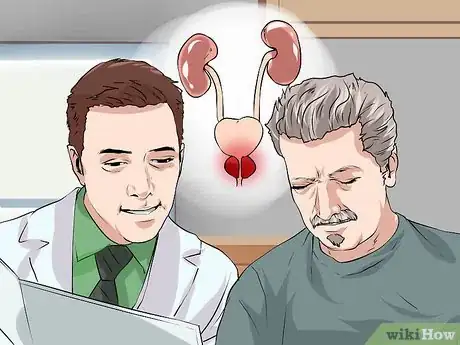

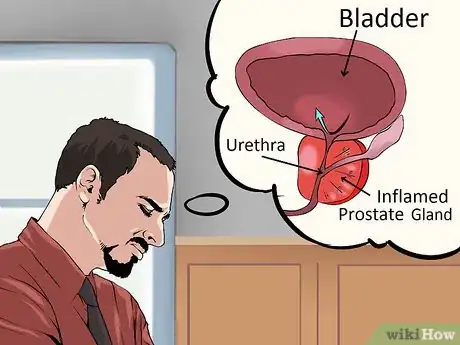




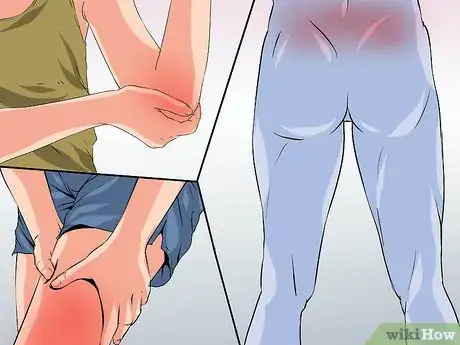



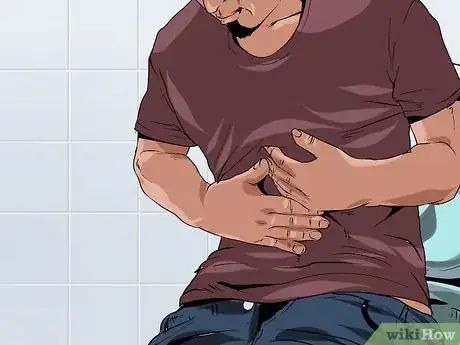


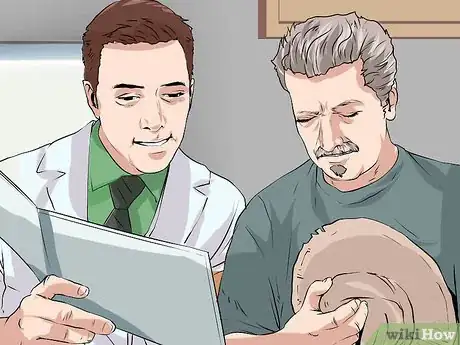

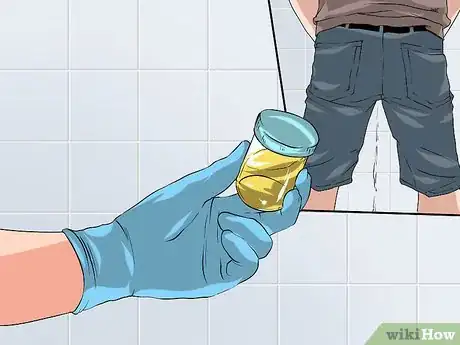
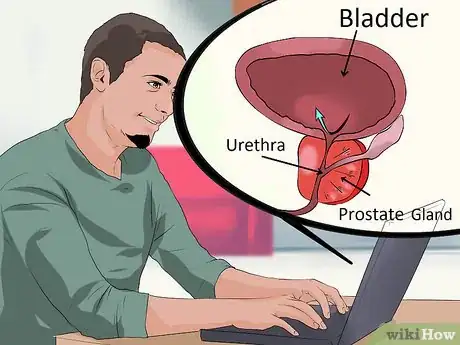









-Step-13.webp)


-Step-8-Version-3.webp)














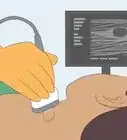




































Medical Disclaimer
The content of this article is not intended to be a substitute for professional medical advice, examination, diagnosis, or treatment. You should always contact your doctor or other qualified healthcare professional before starting, changing, or stopping any kind of health treatment.
Read More...